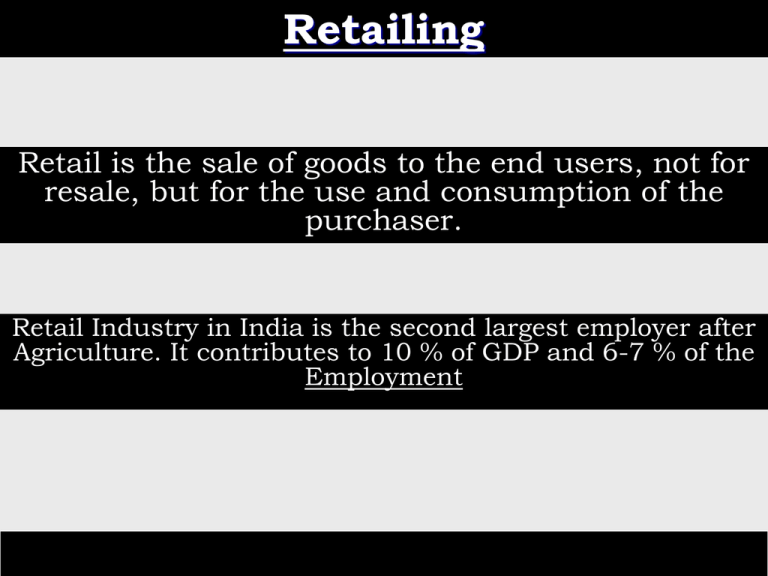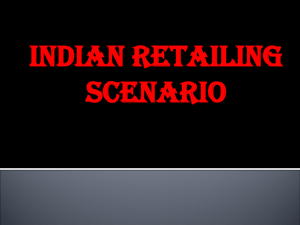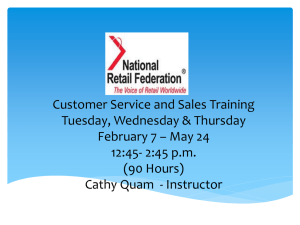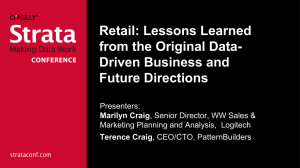Retailing - Agriwatch
advertisement

Retailing Retail is the sale of goods to the end users, not for resale, but for the use and consumption of the purchaser. Retail Industry in India is the second largest employer after Agriculture. It contributes to 10 % of GDP and 6-7 % of the Employment Organised Retailing – Country Wise Share: • • • • • • • USA Western European Countries Argentine Thailand China Malaysia India 80 % 70 % 40 % 40 % 20 % 20 % 06 %** – ** FDI (Foreign Direct Investment is allowed partially) Top 7 Global Retailers Rank Name of Retailer Sales Grocery Sales (%) (USD Bn) 1 Walmart - USA 235 44% 2 Tesco- UK 63 75% 3 Carrefour-France 58 84% 4 Home Depot -USA 55 51% 5 Kroger - USA 55 70% 6 WalGreens -USA 52 75% 7 Aldi Group- Germany 48 18% Corporate- Indian Retail Corporate No of Outlets Remarks Reliance Retail 700+ Biggest Retail Chain & fast Expanding, operating in 14 States. Big Bazaar 164 Fast Expanding, Big Size Stores Bharti - Walmart 105 Retail Stores in NCR, Punjab, UP & Rajasthan, Expanding quickly to South Cash & carry Stores 03 Aditya Birla 500+ Concentration in South(acquired Trinethra and Fab Malls) Spencers 210 Oldest Retailer in India, operates in 27 Cities Metro-AG- Germany 4 Cash and carry stores located at Mumbai, Hyderabad & Kolkatta, Expanding Slowly Growth of organized Retail in India • Organized Retail is 5.5 % of the total Retail Industry and expected to Grow by 10% by 2012. Increasing Consumer aspiration Growing no of Nuclear families Growing Size of working women segment Demand from tier II and III cities and rural markets. Large young working Population Staples Share in Retail Store Category Volume % Margin % Weightage % Oils 30 5-7 14 Pulses 17 16-18 22 Rice 17 12-13 16 Flours 11 12-14 10 Spices 10 22-28 20 Sugar 9 6-7 5 Dry Fruits 3 20-25 7 Salt 1 25-30 2 Wheat 1 15-18 1 Buying Behaviors Staples • Any item that is washed before cooking, the consumer prefers to buy it loose as it’s economical. • Items such as Dals, Rice & Wheat mostly sells In loose. • Dals - No National Brand, all are Pvt label of the Retailers. • Items like Atta, Edible Oil, Powered Spices, salt etc is sold in packets (Branded), because of its Hygienic aspect. Plano- Category Wise Stacking North Stacking from Left To Right Stacking from Top to Bottom Cont…. Plano – Bay Allocation for 32BM Family Bay 32 OIL 6.00 Rice 6.00 Pulses 6.00 Flours Toor 2 3.50 Mung 1 Wheat 0.50 Chana 1 Spices 5.00 Urad/ Masoor 1 Salt 0.50 Minor pulses 1 Sugar 2.50 DF 2.00 Total 32.00 , Pulses Mix in Modern Retail • Major dal - 85 % – Toor, Urad, Moong and Chana, Kabuli and Masoor • Minor dal - 15 % – Green peas, White Peas, Chitra, Red, Sharmili, Lobia, Soyabean, Moth, Pulses Assortment Item Select Value Loose Bins Toor Gujarat Latur Latur/Sawa Moong Desi Desi Desi/Import Urad Desi Import Import Chana Bold Medium Medium Masoor Bold Medium medium Kabuli 42-44 58-60 58-60 Chitra Import G Peas USA Import Canada Pulses Sales Mix - India Types of Pulses Volumes % Toor Dal 24 Chana Dal 23 Mung Dal 16 Urad Dal 10 Peanuts 5 Other Dal 22 Pack Size % 200 gm 5 500 gm 44 1 kg 43 2 kgs 8 Weekly Buying Behavior Monday Tuesday Wednesday Thursday Friday Saturday Sunday : : : : : : : 11% 12% 11 % 11 % 16 % 20 % 19 % Supply Chain & Sourcing Material Flow Bulk Origin Bulk Warehouse Packing Centre Store 1 Store 2 Store 3 Store 4 Indent Flow City Distribution Centre Buying of Dals • Small retailer Store: – Buying locally – Buying at High Price. – Lack economies of Scale • Bigger Retail chains: – – – – – – Buy from origins. Better quality and quality Consistency. Definite demand, makes buying Easy. Better bargaining Power. Can work in Positions if market is bullish. If market drops: loss of profit/ Averaging of Bulk Price. Pricing Policy Teji - Mandi in Retail • Effects are mild – since we operate Pulses Basket • Gestation period ( Bulk Buying to supply at store – 10 days) • Weekly Benchmarking and Price Change • MRP Restrictions • In Teji : Unable to take full advantage • In Mandi : Buying cost goes down margin increases. • Easy to Average ( Since Throughput is high) • Loss of profit. Problems / Challenges • Getting low income groups to shop at our Stores i.e drivers, maid, labourer • High cost of Real estate. • Lack of adequate infrastructure, poor roads, Cold chain, • Lack of availability of skilled manpower. • Unavailability of uniform quality raw material round the year. • Govt Regulations, PFA, Package Commodity Act, Weights & Measures, Factory Act. etc. • Price war among Retailers Thank You








